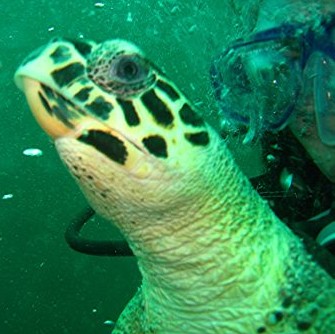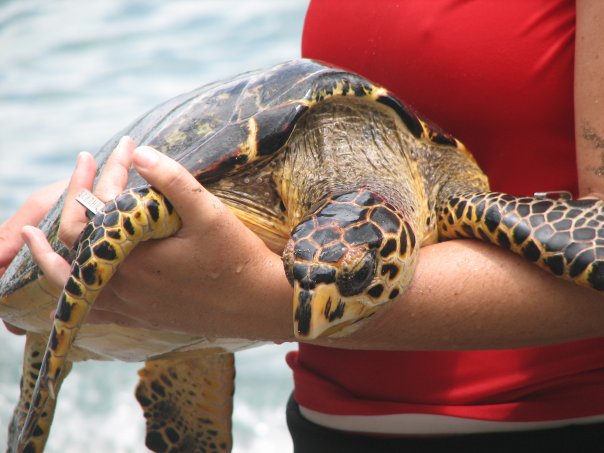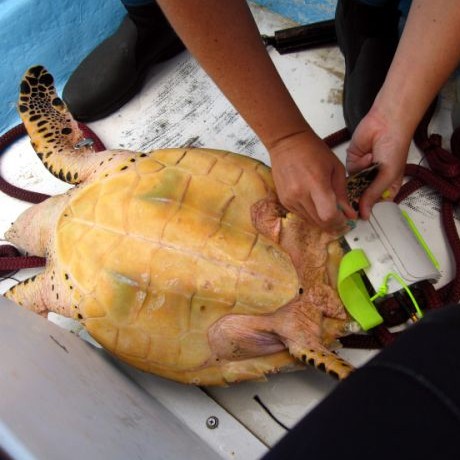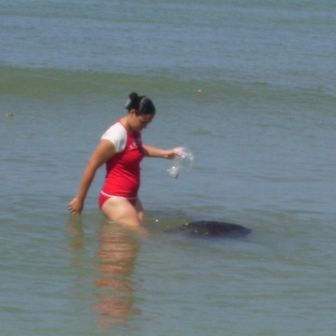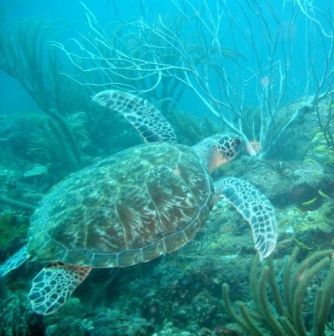 Five species of sea turtle occur around Trinidad and Tobago: the loggerhead Caretta
caretta, the leatherback Dermochelys coriacea, the olive ridley Lepidochelys
olivacea, the green Chelonia mydas, and the hawksbill Eretmochelys imbricata.
All five species have been proposed as Environmentally Sensitive Species by the Environmental
Management Authority (EMA) due to their international conservation status.
Five species of sea turtle occur around Trinidad and Tobago: the loggerhead Caretta
caretta, the leatherback Dermochelys coriacea, the olive ridley Lepidochelys
olivacea, the green Chelonia mydas, and the hawksbill Eretmochelys imbricata.
All five species have been proposed as Environmentally Sensitive Species by the Environmental
Management Authority (EMA) due to their international conservation status.
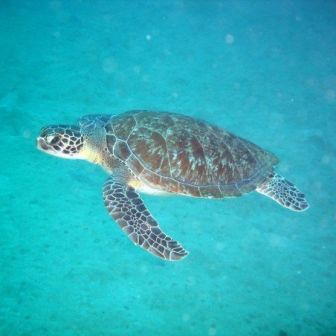 The loggerhead and
olive ridley are relatively uncommon in Trinidad and Tobago, the former as migrant subadults
along the north coast of Trinidad, the latter as an occasional nester. The leatherback
population of Trinidad (and to a lesser extent Tobago) is of global significance, representing
about one seventh of all nestings worldwide, but is currently receiving good protection in
Trinidad (and to a lesser extent Tobago) from community-based ecotourism.
There are several
studies of the leatherback in progress, coordinated by the Wildlife Section of the Forestry
Division. The conservation status of green and hawksbill turtles in Trinidad and Tobago are of
more immediate concern, as these species remain harvested under fisheries legislation,
despite protection near the shore and on nesting beaches. A turtle fishery in Trinidad and
Tobago exploits both species for meat, and the hawksbill potentially for tortoiseshell.
Postgraduate student Michelle Cazabon-Mannette is studying the populations of hawksbill and green
turtles around the reefs and seagrass beds of Tobago from January 2007, funded by the
Government of the Republic of Trinidad and Tobago Research Development Fund and matching
funds from the National Fish and Wildlife Foundation of the USA.
The loggerhead and
olive ridley are relatively uncommon in Trinidad and Tobago, the former as migrant subadults
along the north coast of Trinidad, the latter as an occasional nester. The leatherback
population of Trinidad (and to a lesser extent Tobago) is of global significance, representing
about one seventh of all nestings worldwide, but is currently receiving good protection in
Trinidad (and to a lesser extent Tobago) from community-based ecotourism.
There are several
studies of the leatherback in progress, coordinated by the Wildlife Section of the Forestry
Division. The conservation status of green and hawksbill turtles in Trinidad and Tobago are of
more immediate concern, as these species remain harvested under fisheries legislation,
despite protection near the shore and on nesting beaches. A turtle fishery in Trinidad and
Tobago exploits both species for meat, and the hawksbill potentially for tortoiseshell.
Postgraduate student Michelle Cazabon-Mannette is studying the populations of hawksbill and green
turtles around the reefs and seagrass beds of Tobago from January 2007, funded by the
Government of the Republic of Trinidad and Tobago Research Development Fund and matching
funds from the National Fish and Wildlife Foundation of the USA.
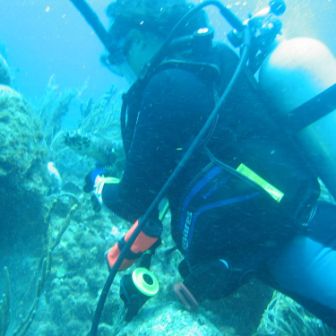 The project concentrates on a population census of green and hawksbill turtles around Tobago
using scuba diving surveys, and an assessment of the turtle fishery by fisher and market
surveys. Alternative values of turtles to ecotourism and ecosystem (reef) health are
assessed using tourist interviews and surveys of coral health and sponge overgrowth. The study
should show the value of these species to the ecology and economy of the island and allow
recommendations for their conservation. The distribution, relative abundance and density of
E. imbricata and C. mydas on the reefs around Tobago will be determined based on
visual swim surveys and interviews conducted with fishers.
The project concentrates on a population census of green and hawksbill turtles around Tobago
using scuba diving surveys, and an assessment of the turtle fishery by fisher and market
surveys. Alternative values of turtles to ecotourism and ecosystem (reef) health are
assessed using tourist interviews and surveys of coral health and sponge overgrowth. The study
should show the value of these species to the ecology and economy of the island and allow
recommendations for their conservation. The distribution, relative abundance and density of
E. imbricata and C. mydas on the reefs around Tobago will be determined based on
visual swim surveys and interviews conducted with fishers.
 Size structure, growth rates and
movements of the turtles around Tobago will be monitored during the course of the project
using mark-release-recapture methodology. On capture, individuals are measured and tagged,
the location recorded and notes made of injury or illness.
A survey of fishers in Tobago will
be conducted to determine the numbers of E. imbricata and C. mydas caught around
the island during the closed and open seasons, and to determine the proportion of fishers'
profits that this accounts for. The value of turtles to fishers and tourists will be measured
and used to estimate the value of different population densities. If the sample size is large
enough and time permits, an estimate will be made of the value of the ecosystem services
provided by E. imbricata on the reefs of Tobago by combining published information with
collected data. The stomach contents of market samples will be examined to identify prey
species eaten by the hawksbill turtle. The relative abundance of preferred prey species on the
reefs around Tobago will be determined through visual swim surveys and compared to the
distribution of E. imbricata. Percentage cover of preferred prey species on the reefs
of Tobago will be compared with that on other Caribbean reefs. Analysis of DNA from
captured turtles and those harvested in the fishery is also projected, to determine the
breeding populations from which these animals derive.
Size structure, growth rates and
movements of the turtles around Tobago will be monitored during the course of the project
using mark-release-recapture methodology. On capture, individuals are measured and tagged,
the location recorded and notes made of injury or illness.
A survey of fishers in Tobago will
be conducted to determine the numbers of E. imbricata and C. mydas caught around
the island during the closed and open seasons, and to determine the proportion of fishers'
profits that this accounts for. The value of turtles to fishers and tourists will be measured
and used to estimate the value of different population densities. If the sample size is large
enough and time permits, an estimate will be made of the value of the ecosystem services
provided by E. imbricata on the reefs of Tobago by combining published information with
collected data. The stomach contents of market samples will be examined to identify prey
species eaten by the hawksbill turtle. The relative abundance of preferred prey species on the
reefs around Tobago will be determined through visual swim surveys and compared to the
distribution of E. imbricata. Percentage cover of preferred prey species on the reefs
of Tobago will be compared with that on other Caribbean reefs. Analysis of DNA from
captured turtles and those harvested in the fishery is also projected, to determine the
breeding populations from which these animals derive.
Hawksbill head; tagged turtle before release; handling on deck
Michelle Cazabon-Mannette received grants for specialist training on techniques for sea turtle biology
at two workshops in 2006. First, "Monitoring Sea Turtles on the Nesting Beach and at Sea -
A Field Training Workshop" hosted and sponsored by the Barbados Sea Turtle Project at the
University of the West Indies Cave Hill and the Wider Caribbean Sea Turtle Conservation
Network (WIDECAST), Barbados, 22-26 May 2006. Second, "Bermuda Turtle Project Field Course in
Biology and Conservation of Sea Turtles" of the Department of Conservation Services,
Ministry of the Environment, Bermuda Government, Bermuda, 16-28 July 2006. The project is
registered as Scientific Research on Biodiversity on the Island of Tobago by the Department
of Natural Resources and the Environment of the Tobago House of Assembly. Michelle Cazabon-Mannette
also works
with the local NGO Save Our Seaturtles Tobago
SOS Tobago,
who are active in all aspects of sea
turtle conservation including patrolling nesting beaches, public education, and care of
injured and stranded turtles.
Feeding "Olive", an olive ridley turtle injured by a boat and unable to dive,
for SOS Tobago;
exercising Olive in the sea; green turtle on an unspoilt reef.
Funding
- TT$ 100,000, Government of the Republic of Trinidad and Tobago Research Development Fund,
project "Sea Turtles in Tobago".
- US$ 16,500, matching funds from National Fish and Wildlife Foundation (Washington DC, USA), project "Sea
Turtles in Tobago, West Indies".
- TT$ 36,000, BPTT/UWI Alumni Scholarship to Michelle Cazabon-Mannette.
- TT$ 14,000 (2008), to attend the 29th Annual Symposium on Sea Turtle Biology, Brisbane, Australia, February 2009.
Partial funding, travel grant, Campus Research and Publication Fund, The University of the West Indies,
St. Augustine.
- TT$ 10,000 (2008), to attend the 29th Symposium on Sea Turtle Biology, Brisbane, Australia, February 2009.
Partial funding, Turtle Village Trust, Port of Spain, Trinidad and Tobago.
- TT$ 31,730 (2012), The sea turtles on the reefs of Tobago. Research grant (Ph.D. upgrade), Campus Research and
Publication Fund, The University of the West Indies, St. Augustine.
- TT$ 15,770 (2013), to attend the 34th Annual Symposium on Sea Turtle Biology and Conservation, New Orleans, and visit
the University of North Carolina, Wilmington, USA,
April 2014. Partial funding, travel grant, Campus Research and Publication Fund, The University of the West Indies,
St. Augustine.
- TT$ 4,346 (2013), to attend the 34th Annual Symposium on Sea Turtle Biology and Conservation, New Orleans, and visit
the University of North Carolina, Wilmington, USA,
April 2014. Partial funding, departmental funds, Department of Life Sciences, The University of the West Indies,
St. Augustine.
- US$ 500 (2014), to attend the 34th Annual Symposium on Sea Turtle Biology and Conservation, New Orleans, USA,
April 2014. Travel Grant, International Sea Turtle Society.
- TT$ 9,185 (2015), to attend the 36th Annual Symposium on Sea Turtle Biology and Conservation, Lima, Peru,
March 2016. Travel grant, Campus Research and Publication Fund, The University of the West Indies, St. Augustine.
Supervision
- Chief supervisor: Prof. Adrian Hailey, Department of Life Sciences, The University of the West
Indies, St. Augustine.
- Co-supervisor: Prof. Julia Horrocks, Department of Biological and Chemical Sciences,
University of the West Indies, Cave Hill, Barbados. (Turtle Biology)
- Advisor: Prof. Peter W. Schuhmann, Department of Economics and Finance, Cameron School of
Business, University of North Carolina, Wilmington, USA. (Environmental Economics)
Results
- Cazabon-Mannette, M., Schuhmann, P. W., Hailey, A. & Horrocks, J. (2017). Estimates of the non-market value
of sea turtles in Tobago using stated preference techniques. J. Env. Man. 192: 281-291.
- Cazabon-Mannette, M. (2016). Ecology and use of nearshore foraging sea turtle populations around Tobago, with an
emphasis on hawksbills. Thesis, Department of Life Sciences, The University of the West Indies, St. Augustine,
Trinidad and Tobago. Ph.D. in Environmental Biology awarded 2016, with High Commendation.
- Cazabon-Mannette, M., Browne, D., Austin, N., Hailey, A. & Horrocks, J. (2016). Genetic structure of the
hawksbill turtle rookery and foraging aggregation in Tobago, West Indies. J. Exp. Mar. Biol. Ecol.
485: 94-101. journal link
- Schuhmann, P. W., Cazabon-Mannette, M., Gill, D., Casey, J. F. & Hailey, A. (2013). Willingness to
pay to avoid high encounter levels at dive sites in the Caribbean. Tourism Mar. Environ. 9: 81-94.
pdf .
download
- Hailey, A. & Cazabon-Mannette, M. (2011). Conservation of herpetofauna in the Republic of Trinidad
and Tobago. In: Hailey, A., Wilson, B.S. and Horrocks, J.A. (Eds), Conservation of Caribbean Island
Herpetofaunas, Volume 1, Conservation Biology and the Wider Caribbean, pp 183-217. Leiden: Brill.
b/w pdf . colour pdf .
download
 Five species of sea turtle occur around Trinidad and Tobago: the loggerhead Caretta
caretta, the leatherback Dermochelys coriacea, the olive ridley Lepidochelys
olivacea, the green Chelonia mydas, and the hawksbill Eretmochelys imbricata.
All five species have been proposed as Environmentally Sensitive Species by the Environmental
Management Authority (EMA) due to their international conservation status.
Five species of sea turtle occur around Trinidad and Tobago: the loggerhead Caretta
caretta, the leatherback Dermochelys coriacea, the olive ridley Lepidochelys
olivacea, the green Chelonia mydas, and the hawksbill Eretmochelys imbricata.
All five species have been proposed as Environmentally Sensitive Species by the Environmental
Management Authority (EMA) due to their international conservation status.
 The loggerhead and
olive ridley are relatively uncommon in Trinidad and Tobago, the former as migrant subadults
along the north coast of Trinidad, the latter as an occasional nester. The leatherback
population of Trinidad (and to a lesser extent Tobago) is of global significance, representing
about one seventh of all nestings worldwide, but is currently receiving good protection in
Trinidad (and to a lesser extent Tobago) from community-based ecotourism.
There are several
studies of the leatherback in progress, coordinated by the Wildlife Section of the Forestry
Division. The conservation status of green and hawksbill turtles in Trinidad and Tobago are of
more immediate concern, as these species remain harvested under fisheries legislation,
despite protection near the shore and on nesting beaches. A turtle fishery in Trinidad and
Tobago exploits both species for meat, and the hawksbill potentially for tortoiseshell.
Postgraduate student Michelle Cazabon-Mannette is studying the populations of hawksbill and green
turtles around the reefs and seagrass beds of Tobago from January 2007, funded by the
Government of the Republic of Trinidad and Tobago Research Development Fund and matching
funds from the National Fish and Wildlife Foundation of the USA.
The loggerhead and
olive ridley are relatively uncommon in Trinidad and Tobago, the former as migrant subadults
along the north coast of Trinidad, the latter as an occasional nester. The leatherback
population of Trinidad (and to a lesser extent Tobago) is of global significance, representing
about one seventh of all nestings worldwide, but is currently receiving good protection in
Trinidad (and to a lesser extent Tobago) from community-based ecotourism.
There are several
studies of the leatherback in progress, coordinated by the Wildlife Section of the Forestry
Division. The conservation status of green and hawksbill turtles in Trinidad and Tobago are of
more immediate concern, as these species remain harvested under fisheries legislation,
despite protection near the shore and on nesting beaches. A turtle fishery in Trinidad and
Tobago exploits both species for meat, and the hawksbill potentially for tortoiseshell.
Postgraduate student Michelle Cazabon-Mannette is studying the populations of hawksbill and green
turtles around the reefs and seagrass beds of Tobago from January 2007, funded by the
Government of the Republic of Trinidad and Tobago Research Development Fund and matching
funds from the National Fish and Wildlife Foundation of the USA.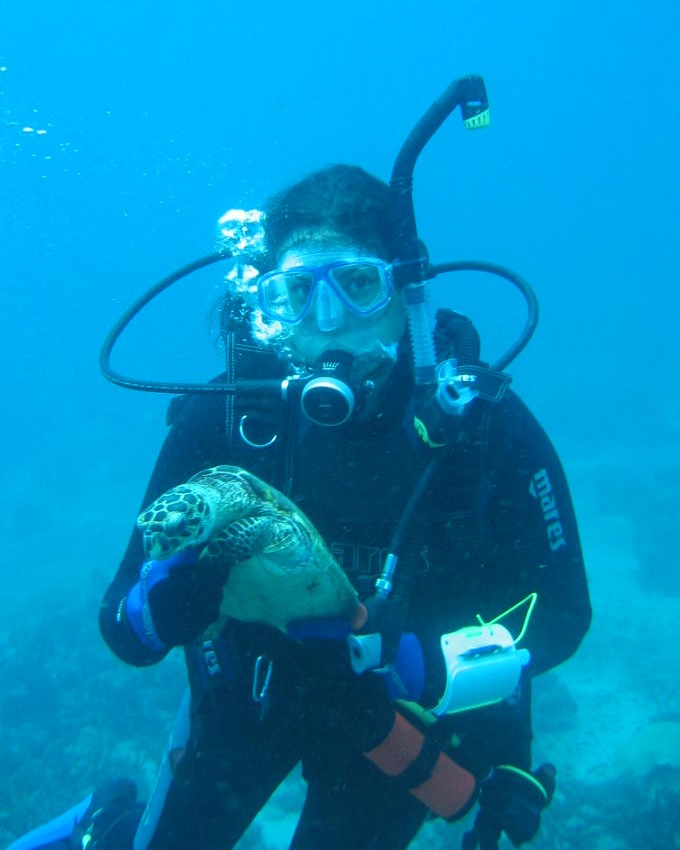
 The project concentrates on a population census of green and hawksbill turtles around Tobago
using scuba diving surveys, and an assessment of the turtle fishery by fisher and market
surveys. Alternative values of turtles to ecotourism and ecosystem (reef) health are
assessed using tourist interviews and surveys of coral health and sponge overgrowth. The study
should show the value of these species to the ecology and economy of the island and allow
recommendations for their conservation. The distribution, relative abundance and density of
E. imbricata and C. mydas on the reefs around Tobago will be determined based on
visual swim surveys and interviews conducted with fishers.
The project concentrates on a population census of green and hawksbill turtles around Tobago
using scuba diving surveys, and an assessment of the turtle fishery by fisher and market
surveys. Alternative values of turtles to ecotourism and ecosystem (reef) health are
assessed using tourist interviews and surveys of coral health and sponge overgrowth. The study
should show the value of these species to the ecology and economy of the island and allow
recommendations for their conservation. The distribution, relative abundance and density of
E. imbricata and C. mydas on the reefs around Tobago will be determined based on
visual swim surveys and interviews conducted with fishers.
 Size structure, growth rates and
movements of the turtles around Tobago will be monitored during the course of the project
using mark-release-recapture methodology. On capture, individuals are measured and tagged,
the location recorded and notes made of injury or illness.
A survey of fishers in Tobago will
be conducted to determine the numbers of E. imbricata and C. mydas caught around
the island during the closed and open seasons, and to determine the proportion of fishers'
profits that this accounts for. The value of turtles to fishers and tourists will be measured
and used to estimate the value of different population densities. If the sample size is large
enough and time permits, an estimate will be made of the value of the ecosystem services
provided by E. imbricata on the reefs of Tobago by combining published information with
collected data. The stomach contents of market samples will be examined to identify prey
species eaten by the hawksbill turtle. The relative abundance of preferred prey species on the
reefs around Tobago will be determined through visual swim surveys and compared to the
distribution of E. imbricata. Percentage cover of preferred prey species on the reefs
of Tobago will be compared with that on other Caribbean reefs. Analysis of DNA from
captured turtles and those harvested in the fishery is also projected, to determine the
breeding populations from which these animals derive.
Size structure, growth rates and
movements of the turtles around Tobago will be monitored during the course of the project
using mark-release-recapture methodology. On capture, individuals are measured and tagged,
the location recorded and notes made of injury or illness.
A survey of fishers in Tobago will
be conducted to determine the numbers of E. imbricata and C. mydas caught around
the island during the closed and open seasons, and to determine the proportion of fishers'
profits that this accounts for. The value of turtles to fishers and tourists will be measured
and used to estimate the value of different population densities. If the sample size is large
enough and time permits, an estimate will be made of the value of the ecosystem services
provided by E. imbricata on the reefs of Tobago by combining published information with
collected data. The stomach contents of market samples will be examined to identify prey
species eaten by the hawksbill turtle. The relative abundance of preferred prey species on the
reefs around Tobago will be determined through visual swim surveys and compared to the
distribution of E. imbricata. Percentage cover of preferred prey species on the reefs
of Tobago will be compared with that on other Caribbean reefs. Analysis of DNA from
captured turtles and those harvested in the fishery is also projected, to determine the
breeding populations from which these animals derive. 